Southwest Michigan field crops update – June 17, 2021
Upcoming cooler and wetter weather will be a welcome source of relief for crops that have been suffering from drought conditions and high evapotranspiration rates so far this season.

Weather
This past week saw temperatures 5-7 degrees Fahrenheit above normal in the south central and southwest regions with daily wind speeds in the teens most days, resulting in high evapotranspiration (ET) rates. We are currently running about one week ahead of normal in heat units (GDD50) with daily accumulations of 20-30 units for most of June so far. This will be changing as a weather system in the western U.S. makes it way into Michigan this weekend, with daily GDD accumulations in the teens (or below) expected for the coming week. Weekly ET rates are forecasted to be between 1.4 and 1.6 inches in the coming week. The 6-10 and 8-14 day outlooks are predicting cooler than normal temperatures for the remainder of the month.
The drought has continued with most areas having received 50-75% of normal rainfall in the past month. According to the current version of the drought monitor, most of our region is still in D1 or D2 drought. As was the case last week, scattered showers across the region dropped much-needed rain in some locations while leaving nearby areas wanting. However, good news is on the way! With two approaching weather systems—one early Friday morning and the other late Sunday night—that show strong chances of widespread precipitation across the state, we could see between 0.75 and 1.5 inches of rain this coming week. The medium-range outlooks are predicting normal to wetter than normal conditions for the remainder of June.
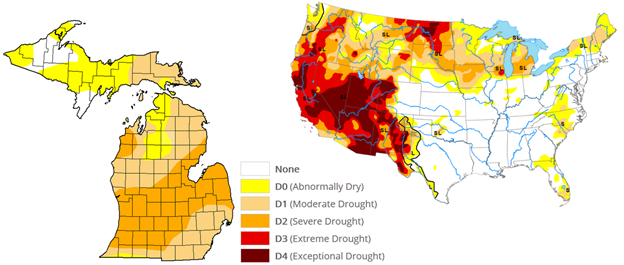
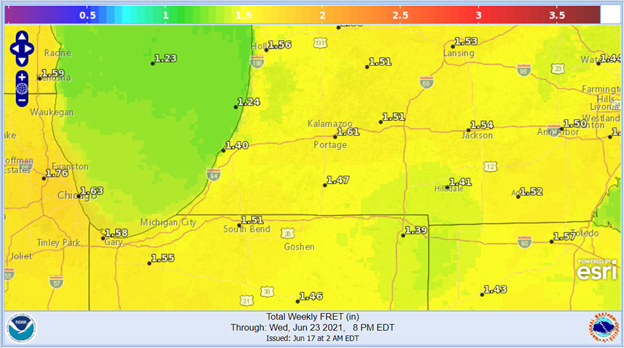

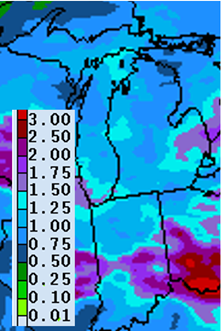

Crops and pests
Wheat continues to look healthy where soil moisture has been adequate, and no reports have come in of insect issues. Michigan State University Extension field crops pathologist Marty Chilvers says wet conditions between now and harvest may exacerbate any head infections that occurred during flowering, but risk levels remain low with overall dry conditions to date.
Forages were the topic of this week’s Field Crops Virtual Breakfast with forage specialist Kim Cassida talking about options for what to do about tight supplies this season. Hay stocks are at a level we have not seen in quite a while, and with average hay yields being relatively low in the past several years, there is likely to be a tight supply this year. With corn prices being high, hay acreage typically declines which serves to increase the tightness of supplies. Impact from dry conditions on a perennial crop are cumulative, and with the freeze events that happened earlier this spring, yields from the current crop may be affected beyond this droughty year.
Cassida outlined three strategies for producing forage in situations like these: 1) plant a double-crop of silage corn followed by a winter forage species such as winter tricale or rye that would be chopped at flag leaf; 2) double-crop an annual forage such as oats, spring triticale, teff, Italian or annual ryegrass, crabgrass (that was an interesting discussion), or brassicas after wheat (tune in to the July 1 Field Crops Virtual Breakfast, “Cover Crops after Wheat” with Dean Baas for further considerations); and 3) grazing livestock on cover crops.
If you missed the Field Crops Virtual Breakfast this week, you can watch the recording here: Forage Management & Supply in a Drought.
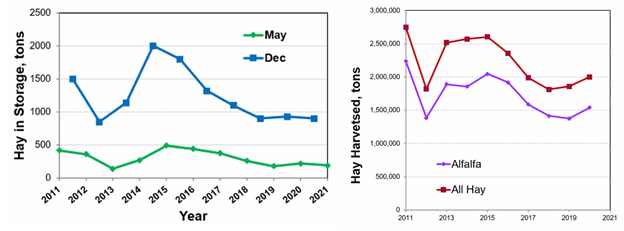
Corn that has received timely rain or irrigation looks healthy and has reached V8 to V9 in earlier-planted fields, and sidedress applications in these fields are nearing completion. With the high number of heat units accumulated so far this year, we have been adding about two leaves per week recently, each stage taking roughly 66 GDDs (base 50). The Useful 2 Usable website is a good resource for estimating dates for key growth stages like silking and black layer. You can input the planting date and days to maturity (and GDDs to silking and black layer if provided by the seed company) to see how the crop will progress based on historic climate averages. For example, the graphic below of 103-day corn planted on May 1 near Kalamazoo should reach silking around July 18.
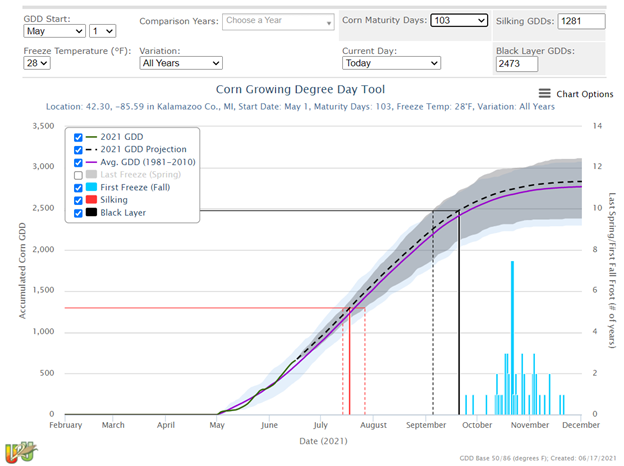
Soybean in fields planted in early May have reached V4 with crop conditions mirroring that of corn. Many reports of frost damage from the May 29-30 event have come in, especially with beans that had reached at least VE by that time even though low temperatures only reached down to the low 30s. Some farmers have chosen to replant portions of fields, although frosted plants have rebounded well with good regrowth.
The following are insights shared by MSU Extension field crops entomologist Chris DiFonzo in her latest Fast Fonz Facts.
Asiatic garden beetles have just started to emerge this week in fields in southeast Michigan. This will end the period of grub damage, but adults feed on many horticultural and veg crops.
Soybean aphids were found on small beans at the MSU Saginaw Valley Farm near Reese last Thursday, June 10. I resampled several adjacent plantings at the station yesterday, June 16. Soybeans planted at end of April were 100% of the plants infested with an average of 160 aphids per plant. Soybeans planted mid-May were 66% plants infested with an average of only five aphids per plant.
This is not unusual. The early-planted beans caught the flight of soybean aphid coming off the overwintering host, buckthorn. In the Thumb, the west side of Saginaw County is loaded with buckthorn along streams, woodlots and roadsides, and this is a historical source of aphids in the spring. The winged migrants get blown on wind from west to east towards eastern Saginaw and Tuscola Counties. Meanwhile, the May-planted beans were likely infested recently by winged migrants produced nearby on the April beans, so that infestation is just getting started.
Should these fields be treated? Absolutely not. Right now there is a battle going on under the canopy, a battle between the aphids versus their natural enemies. In the years after soybean aphid was discovered in Michigan, the aphids won the battle. But then natural enemies figured out that aphids are a delicious snack and since 2007 they get the upper hand. Early season infestations are quickly found and usually wiped out. Yesterday we found several species of adult ladybugs as well as eggs and larvae of the next generation. More importantly, multiple species of parasitoid wasps are already attacking and killing aphids. Nearly all of the plants in the April planted field have mummies on them and the majority of plants in the May planted field do too. When parasitoid populations ramp up, they act almost like a pathogen sweeping thru the aphid population.
My recommendation: Walk the earliest (April) planted fields now and check for aphids on the growing point. Don’t just sample on the edge – aphids tend to land on field edges so edges don’t reflect the population across the field. Wait and watch the infestation. The threshold in soybeans is 250 aphids per plant – in visual terms, this will be every plant infested with a couple hundred healthy fat green aphids on the new growth. The threshold is most applicable in R1-R3 stage beans, not for veg stage beans.
From past experience, infestations on smaller veg stage beans tend to get destroyed by natural enemies. And our studies spraying veg stage infestations resulted in zero impact on yield. In fact, spraying too early may increase your aphid problems by wiping out natural enemies, setting you up for another spray, and maybe another, later in the season. Spraying at the first sign of aphids and too early is what has created numerous problems for growers in western states. They not only have lower parasitoid populations, but they created a pyrethroid resistant aphid problem. Bottom line – watch your fields for the next couple of weeks to see what happens.



 Print
Print Email
Email